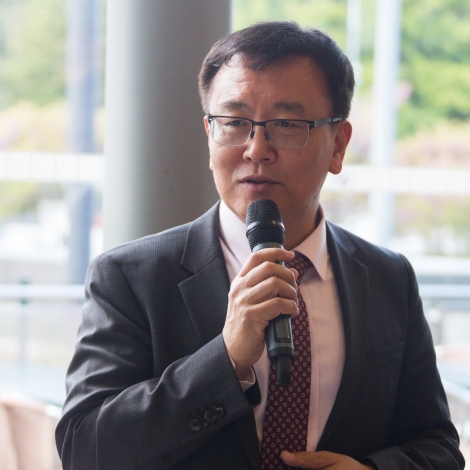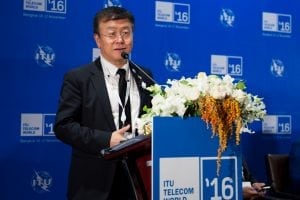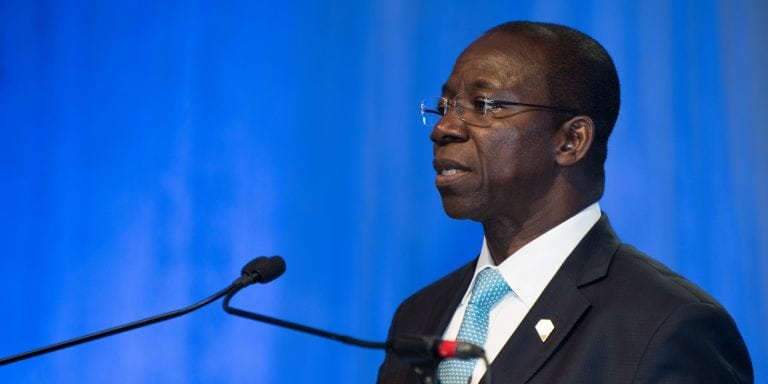The mobile phone revolution in developing countries was possible in large part because of standards in Internet and communications technology developed by the International Telecommunication Union (ITU), Chaesub Lee says. Dr. Lee directs the Telecommunication Standardization Bureau at International Telecommunication Union (ITU-T). Since he took the position in 2015, Dr. Lee has guided the ITU’s standardization arm in the development of standards that support ICTs around the world, including those in developing countries, rural and other traditionally underserved areas.
Dr. Lee began a career in the 1980s at Korea Telecom. For the next 30 years, he held positions in Korean institutions where he specialized in integrated services digital networks, global information infrastructure, Internet protocol, next-generation networks, Internet protocol television and cloud computing.
In advance of ITU Telecom World 2017 conference in Busan, Korea, we asked Chaesub Lee five questions.
E4C: What can you tell us about ITU’s standards for ICTs in global development?
CL: International ICT standards are one of the most important tools to address the digital divide. They increase competition and reduce costs, enabling companies in emerging markets to access global markets. Standards-based ICT infrastructure offers a reliable platform to encourage ICT-enabled social and economic development.
Examples of ITU standards’ global applicability:
Estimates suggest that 95 percent of international traffic is carried over optical transport networks built in conformance with ITU standards. These fiber-optic information superhighways provide the backbone of the Information Society, holding together the rich diversity of ICT networks, services and devices that have become so essential to business and daily life.
Adapting mature technologies to new applications is a path less traveled in technical standardization, however this was the approach taken in the development of an ITU standard to bring broadband to rural communities
Benefiting from technology developments for the convenient use of video, video traffic has come to account for over 60 percent bandwidth use, a figure expected to rise to over 80 percent by year 2020. The dominance of ITU’s video coding standards led to ITU receiving a Primetime Emmy award, recognizing the engineers responsible for the fact that almost all video we view, over any medium, is coded using ITU standards.
An example of an ITU standard expressly targeted at development:
International standards are generally developed to support international aspects of communications. However, looking at standards targeted specifically at developing countries, we can make an example of Recommendation ITU-T L.1700.
ITU-T L.1700 builds on established technologies to identify the founding principles for low-cost, sustainable broadband infrastructure, with a special focus on rural communications in developing countries.
ITU’s international standards reflect the state of the art in ICT. Most ITU standards aim to provide common platforms for growth and innovation in emerging fields of ICT. Adapting mature technologies to new applications is a path less traveled in technical standardization, however this was the approach taken in the development of an ITU standard to bring broadband to rural communities, Recommendation ITU-T L.1700, “Requirements and framework for low-cost sustainable telecommunications infrastructure for rural communications in developing countries.”
ITU-T L.1700 builds on established technologies to identify the founding principles for low-cost, sustainable broadband infrastructure, with a special focus on rural communications in developing countries.
E4C: How do you incorporate the views of people in developing countries when setting standards for products that they create and use?
CL: The aim of ITU’s international standardization work is to provide a common basis for ICT development worldwide. To achieve this, the ITU standardization process must be globally inclusive.
This is why ITU-T standardization has integrated a development dimension unmatched by other standards bodies – our Bridging the Standardization Gap (BSG) program aims to improve the capacity of developing countries to participate in the development and implementation of international ICT standards.
Our Bridging the Standardization Gap (BSG) program aims to improve the capacity of developing countries to participate in the development and implementation of international ICT standards.
The BSG programme supports a range of services to developing countries. To give just a few examples:
We have introduced a new ‘hands-on’ training program for delegates from developing countries to improve the effectiveness of their participation in ITU-T standardization work. This is a new form of standards capacity-building to assist delegates in drawing maximum value from their participation in ITU-T standardization. The training courses cover topics such as the effective development and presentation of contributions to ITU meetings, as well as strategies to gather support for proposals and build international consensus.
We provide financial support to delegates from certain eligible developing countries to assist their participation in ITU-T standardization work.
‘Regional Groups’ within our standardization expert groups (‘ITU-T Study Groups’) assist developing countries in coordinating regional contributions to ITU-T work, in addition enabling them to organize meetings closer to home.
We assist developing countries in their establishment of national standardization secretariats to coordinate a country’s participation in international standardization activities.
E4C: Can you share a personally meaningful example of how your work has made a difference in a developing region?
CL: The “Connecting the World” vision has been realized with wonderful harmonization between fixed and mobile communication. The “fixed communication infrastructures” have been continuously improved in their capacity and economic availability. This effort significantly contributed to connecting countries, villages and houses.
The speed of IMT deployment and mobile phone adoption in developing countries was to a large degree dependent on standards.
In addition, the “mobile revolution” at the turn of the century made a significant contribution to connecting people and this was the result of a remarkable standards effort. IMT (International Mobile Telecommunication) standards have brought mobile-wireless connectivity to around 90 per cent of the world’s people. Almost everyone has a mobile phone today and it is extraordinary to think how fast this was achieved. The speed of IMT deployment and mobile phone adoption in developing countries was to a large degree dependent on standards, standards which created the market certainty required for industry players to invest in the rollout of mobile-wireless infrastructure.
E4C: What are some of the activities that you predict will become important and require standardization in developing countries?
CL: It is important that all countries conform with international standards in their deployment of fundamental ICT infrastructure.
However, with respect to ongoing ITU standardization efforts of particular relevance to developing countries, we could make examples of the following.
The Internet of Things and Smart Cities and Communities: Our cities are the main driver of global economic output, but they are also the main culprit of energy consumption and greenhouse gas emissions. Smart cities and communities – and the role played by ICTs in their development and operation – is a topic of great importance to developing countries experiencing rapid urbanization and growing pressure on city services.
Performance, Quality of Service (QoS) and Quality of Experience (QoE): ITU-standardized tools to assess performance, QoS and QoE are highly relevant to operators, helping them to provide the service quality necessary to attract and retain customers. Industry players as well as regulators from developing countries are highly active in this area of ITU work, working to ensure high-quality user experience as networks expand to meet the growing demand for connectivity.
Combating ICT device counterfeiting: Developing countries are strong supporters of ITU-T work to develop technical mechanisms to combat ICT device counterfeiting. ICT counterfeiting poses dangers to the health, safety and privacy of consumers, and the number and range of affected products is growing. Network operators are challenged by QoS degradations, network disruptions and failures in electromagnetic compatibility (EMC). Governments forfeit tax revenues and incur great expense in ensuring compliance with national anti-counterfeiting legislation and reacting to threats to public safety and distortions in labour markets.
Responsible management of EMF: ITU standards provide guidelines to ensure the responsible management of human exposure to the electromagnetic fields (EMF) emitted by mobile and wireless communications infrastructure. ICT infrastructure is expanding fast in developing countries, increasing the relevance of these standardized guidelines. These standards assist countries in ensuring that the deployment of ICT infrastructure does not compromise citizens’ health, and these standards also help governments to provide clear information on EMF to the communities that they serve.
e-Waste: e-Waste is one of the world’s fastest-growing waste streams. Developing countries are looking to ITU standards for guidance on how to handle and treat e-waste efficiently. This efficient management of e-waste is important in mitigating e-waste’s adverse effects on the environment and human health, in addition driving the recycling of valuable raw materials.
Digital financial services: Digital financial services are a promising route to bring people within reach of formal financial services. An estimated 2 billion people worldwide are still without access to a bank account, but 1.6 billion of them have a mobile phone. ITU standardization work is tackling technical aspects of these services, aspects such as security. We are also working with the World Bank Group and the Committee on Payments and Market Infrastructures to assist developing countries in their rollout of digital financial services, with support from the Bill & Melinda Gates Foundation – this programme is known as the ‘Financial Inclusion Global Initiative’.
E4C: What are some of the problems in developing countries that the standards bureau is responding to now?
CL: The biggest challenge to developing countries is the need to increase the value that they draw from international standardization.
The disparity in the standardization capabilities of developing and developed countries continues to be a factor in the persistence of the digital divide. This disparity diminishes opportunities for economic development and technological innovation.
Here we see the importance of ITU’s Bridging the Standardization Gap (BSG) program. The BSG program is central to our efforts to ensure that developing countries are well positioned to capitalize on international standards in their efforts to drive sustainable development.
The BSG program offers valuable assistance to developing countries in their efforts to steer their home markets towards the high performance, reliability and interoperability that results from the coherent deployment of standards-based infrastructure.
E4C: Bonus question:
There was a controversy during WCIT-12 over Internet governance, in which some wanted to preserve the current multi-stakeholder model and others wanted more governmental control. Internet was left out of the International Telecommunication Regulations, but some countries, notably many developing countries, signed on to the governmental control model. What does the standardization bureau have in store for Internet governance and what are the implications for developing countries?
CL: The mandate of ITU’s standardization arm, ITU-T, is to develop the international standards that provide the technical foundations of the ICT ecosystem. These technical standards support interconnection and interoperability, enabling ICT networks and devices to ‘speak the same language’. The Internet uses telecommunication networks as connecting infrastructures and Telecom/ICT services use the Internet as networking infrastructure, so it would be desirable to have better harmonization between Telecom/ICT and Internet governance.


